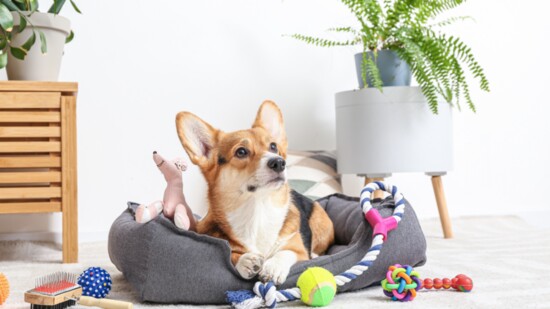Oh, the thrill of getting a dog! The sloppy kisses, tail wags, and snuggles on the couch. And don’t forget about all the outdoor adventures! From long walks to splashing in puddles to chasing squirrels (the dog, not you), you can foresee many wonderful days ahead with a new furry member in your household.
There’s just something so exciting about getting a four-legged friend. To help our readers, we reached out to the experts at Animal Oasis of the Rockies in Broomfield to provide some advice on what to expect when you’re expecting a dog. Dr. Stacey Huber shared the following tips.
What’s the Best Breed for Me/Us?
To determine what type of dog to consider, think about what would be the best fit for your personality and lifestyle:
-
Are you an active person or family? Or are you more laid-back?
-
Are you financially prepared to afford a dog, specifically certain breeds that may need more attention and vet visits?
-
Do you already have a pet(s)?
-
Do you have children or are you thinking of having children?
-
Do you plan on training your dog?
-
What is your work/life balance? Will you be gone for long periods of time throughout the day?
If you’re an active person or family, consider a younger dog and/or an active breed so they can join in on your activities. Weimaraners, Dalmatians, Vizslas, German Shorthaired Pointers, Rhodesian Ridgebacks and more are some breeds to consider.
If you have or are planning to have children, some great family-friendly breeds include Beagles, Poodles, King Charles Cavaliers, Retrievers, Collies and many more.
When you find yourself debating between breeds, there are organizations that do temperament testing to observe a dog before considering a breed or rescue. Either way, you should definitely consider other pets in the household, and if possible, let the new addition meet the other pets before making a final decision. Answering these questions as well as reviewing the following tips will help guide you to the perfect pooch for you and your family.
1.Be Prepared for Your New Addition
Be prepared to welcome your new dog home by having the right supplies! On day one, have the following items:
-
A crate—make sure the crate size will be enough space for your dog to grow.
-
Water and dog food bowls.
-
Choose a healthy, high-quality, AAFCO-approved food for puppies or all life stages, and slowly transition your pet from the original food to the new high-quality food. Also, make sure you get enough food from the breeder or rescue for at least 14 days. Please note that it’s not recommended to feed dogs a grain-free diet.
-
Dog treats for training.
-
A collar and leash.
-
A bed.
-
Dog toys.
2. Make Your Pet Feel at Home and Safe
Identify a centrally located space for the dogs belongings so they can feel included. Don’t forget to puppy-proof your home (whether you’re getting a puppy or an older dog)! A new pet will be very curious and possibly teething, so put things away like exposed cords and anything you don’t want to get chewed up.
3. Take Care of Your Dog’s Health
Just like humans, dogs need regular wellness exams, especially when you first bring a dog home. All dogs need vaccines to keep them safe and healthy and prevent them from getting diseases.
If you don’t have a veterinarian already, Dr. Stacey Huber of Animal Oasis of the Rockies recommends contacting one before you bring your dog home. That way, you can bring your dog in to see a vet shortly after settling in.
Dr. Huber also recommends considering pet insurance, as a company like Pawlicy.com could save you thousands of dollars over your pet’s life.
4. Shower Your Dog with Love
When you bring your dog home, it’s time to bond! Here are some fun ways to show your dog some love:
-
Use your dog voice! It may seem a little silly at first, but studies show that dogs actually understand human language better than previously thought.
-
Cuddle or nap with your dog. Most dogs enjoy physical contact, so a cuddle provides comfort and connection.
-
Pet your dog. A lot! The simple act of petting your dog releases oxytocin (a hormone that helps reduce stress) in you and your dog, so while you’re cuddling, give your dog some extra pets. Rub your dog’s ears too—their ears are full of feeling receptors.
Last but not least, take lots of pictures of your new addition! And enjoy those sloppy kisses and snuggles for all the days to come!





